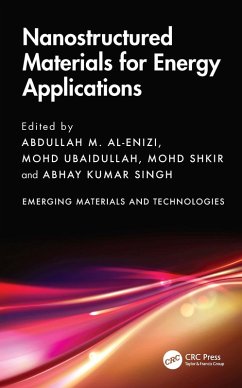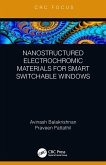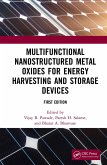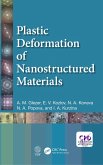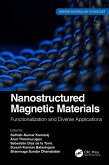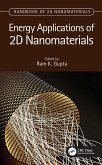Nanostructured Materials for Energy Applications (eBook, PDF)
Redaktion: M. Al-Enizi, Abdullah; Singh, Abhay Kumar; Shkir, Mohd; Ubaidullah, Mohd


Alle Infos zum eBook verschenken

Nanostructured Materials for Energy Applications (eBook, PDF)
Redaktion: M. Al-Enizi, Abdullah; Singh, Abhay Kumar; Shkir, Mohd; Ubaidullah, Mohd
- Format: PDF
- Merkliste
- Auf die Merkliste
- Bewerten Bewerten
- Teilen
- Produkt teilen
- Produkterinnerung
- Produkterinnerung

Hier können Sie sich einloggen

Bitte loggen Sie sich zunächst in Ihr Kundenkonto ein oder registrieren Sie sich bei bücher.de, um das eBook-Abo tolino select nutzen zu können.
This book demonstrates the necessity of novel methods for the development of nano-structured energy materials with improved characteristics for real-life applications. It explores the prospective of nanoscale science to design and build device technology through novel nanoscale photodetectors, photoconductors, photovoltaics, solar cells, batteries, supercapacitors, fuel cells, hydrogen generation and storage, and so forth. Various kinds of organic, inorganic, and organic-inorganic multilayer thin-film photovoltaic solar cell devices are also addressed.
Features:
Discusses nanotechnology…mehr
- Geräte: PC
- mit Kopierschutz
- eBook Hilfe
- Größe: 30.92MB
![Nanostructured Electrochromic Materials for Smart Switchable Windows (eBook, PDF) Nanostructured Electrochromic Materials for Smart Switchable Windows (eBook, PDF)]() Avinash BalakrishnanNanostructured Electrochromic Materials for Smart Switchable Windows (eBook, PDF)22,95 €
Avinash BalakrishnanNanostructured Electrochromic Materials for Smart Switchable Windows (eBook, PDF)22,95 €![Multifunctional Nanostructured Metal Oxides for Energy Harvesting and Storage Devices (eBook, PDF) Multifunctional Nanostructured Metal Oxides for Energy Harvesting and Storage Devices (eBook, PDF)]() Multifunctional Nanostructured Metal Oxides for Energy Harvesting and Storage Devices (eBook, PDF)64,95 €
Multifunctional Nanostructured Metal Oxides for Energy Harvesting and Storage Devices (eBook, PDF)64,95 €![Plastic Deformation of Nanostructured Materials (eBook, PDF) Plastic Deformation of Nanostructured Materials (eBook, PDF)]() A. M. GlezerPlastic Deformation of Nanostructured Materials (eBook, PDF)47,95 €
A. M. GlezerPlastic Deformation of Nanostructured Materials (eBook, PDF)47,95 €![Nanostructured Magnetic Materials (eBook, PDF) Nanostructured Magnetic Materials (eBook, PDF)]() Nanostructured Magnetic Materials (eBook, PDF)48,95 €
Nanostructured Magnetic Materials (eBook, PDF)48,95 €![Nanostructured Gas Sensors (eBook, PDF) Nanostructured Gas Sensors (eBook, PDF)]() Ankur GuptaNanostructured Gas Sensors (eBook, PDF)114,95 €
Ankur GuptaNanostructured Gas Sensors (eBook, PDF)114,95 €![Emerging Materials for Energy and Sensing Applications (eBook, PDF) Emerging Materials for Energy and Sensing Applications (eBook, PDF)]() Emerging Materials for Energy and Sensing Applications (eBook, PDF)52,95 €
Emerging Materials for Energy and Sensing Applications (eBook, PDF)52,95 €![Energy Applications of 2D Nanomaterials (eBook, PDF) Energy Applications of 2D Nanomaterials (eBook, PDF)]() Energy Applications of 2D Nanomaterials (eBook, PDF)45,95 €
Energy Applications of 2D Nanomaterials (eBook, PDF)45,95 €-
-
-
Features:
- Discusses nanotechnology for the development of energetic nanostructured materials and their device applications
- Combines all three types of nanostructured materials, organic, inorganic, and perovskite, and explores their applications at the device level
- Articulates kinds of preparation methods for advanced energy-related nano-materials and their functionalization for a variety of devices
- Explores the consequence of economizing and combination of 0D, 1D, and 2D nanomaterials to meet the future energy demand
- Establishes the wide range of applications of energetic nanomaterials in photovoltaics (including organic and inorganic)
This book is aimed at graduate students and researchers in photovoltaics, batteries and energy storage, and thermoelectrics.
Dieser Download kann aus rechtlichen Gründen nur mit Rechnungsadresse in A, B, BG, CY, CZ, D, DK, EW, E, FIN, F, GR, HR, H, IRL, I, LT, L, LR, M, NL, PL, P, R, S, SLO, SK ausgeliefert werden.
- Produktdetails
- Verlag: Taylor & Francis eBooks
- Seitenzahl: 344
- Erscheinungstermin: 13. November 2025
- Englisch
- ISBN-13: 9781040440049
- Artikelnr.: 75597928
- Verlag: Taylor & Francis eBooks
- Seitenzahl: 344
- Erscheinungstermin: 13. November 2025
- Englisch
- ISBN-13: 9781040440049
- Artikelnr.: 75597928
- Herstellerkennzeichnung Die Herstellerinformationen sind derzeit nicht verfügbar.
dimensional materials 4 1.2.3 Twödimensional materials 5 1.2.4 Three
dimensional materials 6 1.2.5 Nanostructures 7 1.2.6 Nanoparticles 8 1.2.7 Nanowires and nanotubes 9 1.2.8 Nanolayers or nanocoatings 9 1.2.9 Nanoporous materials 9 1.3 Strategies of nanomaterials synthesis 9 1.3.1 Chemical approaches 10 1.3.1.1 Sol-gel method 11 1.3.1.2 Hydro/solvothermal process 12 1.3.1.3 Polyol method 13 1.3.1.4 Sonochemical process 13 1.3.1.5 Microemulsion process 14 1.3.1.6 Chemical vapor deposition process 14 1.3.1.7 Atomic layer deposition (ALD) process 15 1.4 Physical methods 16 1.4.1 Mechanical approach 16 1.4.1.1 Ball milling method 16 1.4.1.2 Melt mixing approach 16 1.4.1.3 Inert
gas technique 17 1.4.1.4 Pulse vapor deposition method 17 1.4.1.5 Pulsed laser deposition method 18 1.4.1.6 Electron beam vapor deposition method 18 1.4.1.7 Sputtering deposition method 18 1.4.1.8 Arc deposition method 19 1.4.1.9 Laser pyrolysis method 19 1.4.1.10 Flash spray pyrolysis method 20 1.5 Energetic applications of the nano materials 20 1.5.1 Photovoltaic solar cells 20 1.5.1.1 Silicon and thin
film solar cells 21 1.5.1.2 Multijunction solar cells 22 1.5.1.3 Organic solar cells 23 1.5.1.4 Dye
sensitized solar cells (DSSCs) 23 1.5.1.5 Quantum dots
sensitized solar cells (QDSSCs) 25 1.5.2 Carbon nanotubes for optoelectronics 27 1.5.3 Graphene for optoelectronics 30 1.5.4 Transition
metal dichalcogenides 31 1.6 Conclusions 33 References 33 Chapter 2 Photovoltaic energy material nanöstructuration and functionalization 45 Mohanraj Kumar, Sandhiya Murugan, S. Selvaraj, Mohd Shkir and Jih
Hsing Chang 2.1 Introduction 45 2.2 Photovoltaic energy basics 46 2.2.1 How photovoltaic cells work 46 2.2.2 Types of photovoltaic cells 47 2.2.3 Efficiency and challenges 47 2.3 Nanöstructuration in photovoltaic materials 48 2.3.1 Principles of nanöstructuration 48 2.3.2 Benefits of nanöstructuration 49 2.3.3 Nanöstructured materials for photovoltaics 49 2.3.4 Techniques for nanöstructuration 49 2.4 Functionalization of photovoltaic materials 50 2.4.1 Introduction to functionalization 50 2.4.2 Purpose and advantages of functionalization 50 2.4.3 Types of functionalization in photovoltaics 50 2.4.4 Methods for functionalization 51 2.5 Types of nanöstructuration and functionalization 52 2.5.1 Surface nanöstructuration 52 2.5.1.1 Surface texturing 52 2.5.1.2 Nanoparticle deposition 52 2.5.2 Bulk nanöstructuration 53 2.5.2.1 Quantum dots 53 2.5.2.2 Nanowires 53 2.5.3 Chemical functionalization 54 2.5.3.1 Passivation layers 54 2.5.3.2 Dye sensitization 54 2.6 Methods for nanöstructuration and functionalization 54 2.6.1 Physical methods 54 2.6.1.1 Chemical vapor deposition (CVD) 55 2.6.2 Chemical methods 56 2.6.2.1 Sol
gel process 56 2.6.2.2 Chemical bath deposition (CBD) 56 2.6.3 Hybrid methods 56 2.6.3.1 Electrochemical deposition 57 2.6.3.2 Atomic layer deposition (ALD) 57 2.7 Applications and case studies 57 2.7.1 Nanöstructured photovoltaic materials in solar cells 57 2.7.2 Functionalized photovoltaic materials for enhanced performance 57 2.7.3 Success stories and research developments 57 2.8 Challenges and future directions 58 2.8.1 Challenges in nanöstructuration and functionalization 58 2.8.2 Future trends and innovations 58 2.8.3 Sustainability and environmental considerations 58 2.9 Conclusion 58 References 59 Chapter 3 Zerödimensional (0D) nanomaterials and their energy applications 62 Abhay Kumar Singh 3.1 Overview 62 3.2 Nanomaterial unique features 63 3.2.1 Surface area 64 3.2.2 Quantum effects 64 3.2.3 Thermal and electrical conductivity 64 3.2.4 Magnetism 64 3.2.5 Mechanical properties 65 3.2.6 Catalytic support 65 3.2.7 Antimicrobial activity 65 3.3 Types of low
dimensional nanomaterials 65 3.4 Zerödimensional (0D) nanomaterials 65 3.5 Zerödimensional nanomaterials in biosensing 66 3.5.1 0D Nanoparticles 67 3.5.2 0D QDs nanostructures 68 3.5.3 0D Fullerene 69 3.5.4 0D Nanospike 71 3.5.5 Carbon quantum dots (CQDs) 72 3.5.6 Graphene quantum dots (GQDs) 78 3.5.7 Inorganic quantum dots (IQDs) 80 3.5.8 Magnetic nanoparticles (MNPs) 84 3.6 Zerödimensional nanomaterials in photovoltaic 86 3.6.1 Significant features of photovoltaic cell construction 87 3.6.2 Zerödimensional perovskites 88 3.6.2.1 Zerödimensional halide perovskite structure 90 3.6.2.2 Zerödimensional halide perovskites crystal growth 91 3.6.3 Zerödimensional halide perovskites applications 91 3.6.3.1 Optoelectronics 91 3.6.3.2 Light
emitting diodes 93 3.6.3.3 Photodetectors 94 3.6.3.4 Solar cells 95 3.6.3.5 Laser 97 3.7 Conclusions 98 References 98 Chapter 4 1D nanomaterials and their energy applications 111 Ziaul Raza Khan and Mohd Shkir 4.1 Introduction 111 4.2 1D nanomaterials 112 4.3 Development of 1D nanomaterials 112 4.3.1 Chemical vapor deposition 112 4.3.2 Chemical vapor transport 112 4.3.3 Metal organic chemical vapor deposition 113 4.3.4 Hydrothermal 113 4.3.5 Electrospinning 113 4.3.6 Template
assisted synthesis 115 4.4 1D nanomaterials physical properties 115 4.4.1 Optical properties 115 4.4.2 Electrical properties 116 4.5 Applications of 1D nanomaterials for green energy harvesting 116 4.6 Conclusions and future prospects 119 References 119 Chapter 5 Twödimensional nanomaterials and their energy applications 123 Abhay Kumar Singh 5.1 Introduction 123 5.2 Classification of 2D materials 126 5.2.1 2D metal nanomaterials 127 5.2.2 Layered hydroxides 128 5.2.3 Metal
organic framework 130 5.2.4 Xenes 132 5.2.5 Covalent organic framework 135 5.3 2D materials energetic applications 137 5.4 2D materials for photovoltaic application 138 5.4.1 2D perovskite solar cells (PSCs): a brief outline 139 5.4.2 Monoelemental 2D materials for PSCs 140 5.4.3 Transparent conductive electrode (TCE) 142 5.4.4 Electron transporting layer (ETL) 142 5.4.5 Perovskite layer (PL) 143 5.4.6 HTL 147 5.4.7 Conductive back electrode 148 5.5 Dye
sensitized solar cells (DSSCs) 151 5.5.1 2D
NL
based DSSCs 152 5.5.2 Graphene
based DSSCs 153 5.5.3 TiO2
based DSSCs 153 5.5.4 MXene
based DSSCs 155 5.5.5 Black phosphorus (BP)
based DSSCs 155 5.5.6 Chalcogen 2D
NL
based DSSCs 157 5.6 Conclusions 158 References 159 Chapter 6 3D Nanomaterials and their energy applications 175 Valparai Surangani Manikandan, Arun Thirumurugan, Krishnamoorthy Shanmugaraj, Dhandayuthapani Thiyagarajan, Ranjith Kumar Poobalan, Natarajan Chidhambaram, Nagarajan Dineshbabu, Kalpana Kalyanasundaram, and Dhanabalan Shanmuga Sundar 6.1 Introduction 175 6.2 Preparation of 3D nanomaterials 179 6.3 3D Nanomaterials for energy storage 188 6.3.1 3D nanomaterials for supercapacitors 188 6.3.2 3D Nanomaterials for batteries 196 6.3.3 3D nanomaterials for energy conversionelectrocatalytic water splitting (HER, OER) 204 6.4 Conclusion 211 Acknowledgments 212 References 212 Chapter 7 Advanced nanostructured thin films of organic materials for photovoltaic solar cells applications 216 M. Aslam Manthrammel and Mohd Shkir 7.1 Introduction 216 7.1.1 Classification of solar cells 216 7.1.2 Next
generation (third
generation) solar cells 216 7.1.3 Dye
sensitized and quantum dot
sensitized solar cells (DSSCs and QDSSCs) 217 7.1.4 Perovskite solar cells (PSCs) 219 7.2 Organic solar cells (OSCs) 220 7.2.1 Working principle of OSCs 220 7.2.2 Materials 221 7.2.3 Device architectures 221 7.2.3.1 Bilayer OSC fabrication or planar heterojunction architecture 221 7.2.3.2 Bulk heterojunction (BHJ) configuration 222 7.2.3.3 Inverted geometry 223 7.2.4 Working mechanism 224 7.2.4.1 Photon absorption 224 7.2.4.2 The exciton diffusion 225 7.2.4.3 Charge dissociation and transportation 226 7.3 Solar cell characteristics 226 7.4 Recent advancements in the OSCs 227 7.4.1 Efficiency improvements 227 7.4.2 Stability enhancements 228 7.4.3 Tandem (multi
junction) designs 228 7.4.4 Non
fullerene acceptors 228 7.4.5 Scalable manufacturing 228 7.5 Summary 228 References 229 Chapter 8 Advances of nanostructured thin films for their applications in solar cells 231 Arun Kumar Senthilkumar, Mohanraj Kumar, Jih
Hsing Chang, Sandhiya Murugan, Mohd Taukeer Khan and Mohd Shkir 8.1 Introduction 231 8.1.1 Motivation and objectives 231 8.1.2 Overview of the chapter 232 8.2 Solar cells 232 8.2.1 Working principal of a solar cells 233 8.2.2 Electrical characteristic parameter of a solar cells 234 8.2.2.1 Short
circuit current (JSC) 234 8.2.2.2 Open
circuit voltage (VOC) 235 8.2.2.3 Fill factor (FF) 235 8.2.2.4 Power conversion efficiency (
) 236 8.3 Nanostructured thin films: concept, classification, and fabrication methods 236 8.3.1 Concept and classification of nanostructured thin films 236 8.3.2 Fabrication methods of nanostructured thin films 237 8.3.2.1 Mechanical milling 237 8.3.2.2. Vapor deposition 237 8.3.2.3 Laser ablation and electron beam lithography 238 8.3.2.4 Spray pyrolysis 238 8.3.2.5 Cöprecipitation and hydrothermal method 238 8.3.2.6 Sol-gel method 239 8.3.2.7 Inkjet printing 239 8.3.2.8 Spin coating process 239 8.4 Properties and performance of nanostructured thin
film solar cells 240 8.4.1 Optical properties 240 8.4.2 Electrical properties 240 8.4.3 Thermal properties 241 8.4.4 Mechanical properties 241 8.4.5 Structural and morphological properties 242 8.5 Applications of nanostructured thin films in solar cells 242 8.5.1 Nanostructured thin films for crystalline silicon solar cells 243 8.5.2 Nanostructured thin films for thin
film solar cells 244 8.5.2.1 Amorphous silicon solar cells 244 8.5.2.2 Cadmium telluride solar cells 246 8.5.2.3 Copper indium gallium selenide solar cells 247 8.5.2.4 Perovskite solar cells (PSCs) 248 8.5.2.5 Organic solar cells 249 8.5.2.6 Dye
Sensitized solar cells 251 8.5.2.7 Quantum dot solar cells (QDSCs) 252 8.6 Conclusion 253 References 254 Chapter 9 Organic-inorganic materials
based advanced nanostructured thin films for photovoltaic solar cell applications 262 Ashwani Kumar and Mohd Shkir 9.1 Introduction 262 9.2 Heterojunction thin
film solar cells 264 9.3 CDTE thin
film solar cells 265 xiv Contents 9.4 CIGS thin
film solar cells 267 9.5 Perovskite solar cells 268 9.6 Operational principle of hybrid perovskite 269 9.7 Architectures of perovskite solar cells 270 9.8 The compact metal oxide blocking layer 270 9.9 Electron transport layer 271 9.10 Absorbing perovskite layer 272 9.11 The hole transport layer 272 9.12 The electrode contacts 273 9.13 Tandem solar cells 273 9.14 Perovskite
silicon tandem solar cells 274 9.15 Tandem silicon solar cells with cigs crystal 276 9.16 Quantum dot tandem solar cells 277 9.17 Organic
inorganic hybrid tandem solar cells 277 9.18 Conclusion 279 References 279 Chapter 10 Quantum dots/nanoparticles for solar energy applications 283 Ashwani Kumar, Ziaul Raza Khan, Mohd Shkir and Thamrah Alshahrani 10.1 Introduction 283 10.2 Working mechanisms of solar cell 284 10.3 Different generation's solar cells 284 10.4 Lead
based quantum dots 287 10.5 Lead halide perovskite quantum dots 290 10.6 Fabrication techniques of perovskite solar cells 295 10.7 Cadmium
based quantum dots solar cells 297 10.8 Conclusion 301 References 301 Chapter 11 Challenges and future prospects 310 Mohanraj Kumar, Mohd Shkir and Abhay Kumar Singh Acknowledgments 312 References 312 Index 313
dimensional materials 4 1.2.3 Twödimensional materials 5 1.2.4 Three
dimensional materials 6 1.2.5 Nanostructures 7 1.2.6 Nanoparticles 8 1.2.7 Nanowires and nanotubes 9 1.2.8 Nanolayers or nanocoatings 9 1.2.9 Nanoporous materials 9 1.3 Strategies of nanomaterials synthesis 9 1.3.1 Chemical approaches 10 1.3.1.1 Sol-gel method 11 1.3.1.2 Hydro/solvothermal process 12 1.3.1.3 Polyol method 13 1.3.1.4 Sonochemical process 13 1.3.1.5 Microemulsion process 14 1.3.1.6 Chemical vapor deposition process 14 1.3.1.7 Atomic layer deposition (ALD) process 15 1.4 Physical methods 16 1.4.1 Mechanical approach 16 1.4.1.1 Ball milling method 16 1.4.1.2 Melt mixing approach 16 1.4.1.3 Inert
gas technique 17 1.4.1.4 Pulse vapor deposition method 17 1.4.1.5 Pulsed laser deposition method 18 1.4.1.6 Electron beam vapor deposition method 18 1.4.1.7 Sputtering deposition method 18 1.4.1.8 Arc deposition method 19 1.4.1.9 Laser pyrolysis method 19 1.4.1.10 Flash spray pyrolysis method 20 1.5 Energetic applications of the nano materials 20 1.5.1 Photovoltaic solar cells 20 1.5.1.1 Silicon and thin
film solar cells 21 1.5.1.2 Multijunction solar cells 22 1.5.1.3 Organic solar cells 23 1.5.1.4 Dye
sensitized solar cells (DSSCs) 23 1.5.1.5 Quantum dots
sensitized solar cells (QDSSCs) 25 1.5.2 Carbon nanotubes for optoelectronics 27 1.5.3 Graphene for optoelectronics 30 1.5.4 Transition
metal dichalcogenides 31 1.6 Conclusions 33 References 33 Chapter 2 Photovoltaic energy material nanöstructuration and functionalization 45 Mohanraj Kumar, Sandhiya Murugan, S. Selvaraj, Mohd Shkir and Jih
Hsing Chang 2.1 Introduction 45 2.2 Photovoltaic energy basics 46 2.2.1 How photovoltaic cells work 46 2.2.2 Types of photovoltaic cells 47 2.2.3 Efficiency and challenges 47 2.3 Nanöstructuration in photovoltaic materials 48 2.3.1 Principles of nanöstructuration 48 2.3.2 Benefits of nanöstructuration 49 2.3.3 Nanöstructured materials for photovoltaics 49 2.3.4 Techniques for nanöstructuration 49 2.4 Functionalization of photovoltaic materials 50 2.4.1 Introduction to functionalization 50 2.4.2 Purpose and advantages of functionalization 50 2.4.3 Types of functionalization in photovoltaics 50 2.4.4 Methods for functionalization 51 2.5 Types of nanöstructuration and functionalization 52 2.5.1 Surface nanöstructuration 52 2.5.1.1 Surface texturing 52 2.5.1.2 Nanoparticle deposition 52 2.5.2 Bulk nanöstructuration 53 2.5.2.1 Quantum dots 53 2.5.2.2 Nanowires 53 2.5.3 Chemical functionalization 54 2.5.3.1 Passivation layers 54 2.5.3.2 Dye sensitization 54 2.6 Methods for nanöstructuration and functionalization 54 2.6.1 Physical methods 54 2.6.1.1 Chemical vapor deposition (CVD) 55 2.6.2 Chemical methods 56 2.6.2.1 Sol
gel process 56 2.6.2.2 Chemical bath deposition (CBD) 56 2.6.3 Hybrid methods 56 2.6.3.1 Electrochemical deposition 57 2.6.3.2 Atomic layer deposition (ALD) 57 2.7 Applications and case studies 57 2.7.1 Nanöstructured photovoltaic materials in solar cells 57 2.7.2 Functionalized photovoltaic materials for enhanced performance 57 2.7.3 Success stories and research developments 57 2.8 Challenges and future directions 58 2.8.1 Challenges in nanöstructuration and functionalization 58 2.8.2 Future trends and innovations 58 2.8.3 Sustainability and environmental considerations 58 2.9 Conclusion 58 References 59 Chapter 3 Zerödimensional (0D) nanomaterials and their energy applications 62 Abhay Kumar Singh 3.1 Overview 62 3.2 Nanomaterial unique features 63 3.2.1 Surface area 64 3.2.2 Quantum effects 64 3.2.3 Thermal and electrical conductivity 64 3.2.4 Magnetism 64 3.2.5 Mechanical properties 65 3.2.6 Catalytic support 65 3.2.7 Antimicrobial activity 65 3.3 Types of low
dimensional nanomaterials 65 3.4 Zerödimensional (0D) nanomaterials 65 3.5 Zerödimensional nanomaterials in biosensing 66 3.5.1 0D Nanoparticles 67 3.5.2 0D QDs nanostructures 68 3.5.3 0D Fullerene 69 3.5.4 0D Nanospike 71 3.5.5 Carbon quantum dots (CQDs) 72 3.5.6 Graphene quantum dots (GQDs) 78 3.5.7 Inorganic quantum dots (IQDs) 80 3.5.8 Magnetic nanoparticles (MNPs) 84 3.6 Zerödimensional nanomaterials in photovoltaic 86 3.6.1 Significant features of photovoltaic cell construction 87 3.6.2 Zerödimensional perovskites 88 3.6.2.1 Zerödimensional halide perovskite structure 90 3.6.2.2 Zerödimensional halide perovskites crystal growth 91 3.6.3 Zerödimensional halide perovskites applications 91 3.6.3.1 Optoelectronics 91 3.6.3.2 Light
emitting diodes 93 3.6.3.3 Photodetectors 94 3.6.3.4 Solar cells 95 3.6.3.5 Laser 97 3.7 Conclusions 98 References 98 Chapter 4 1D nanomaterials and their energy applications 111 Ziaul Raza Khan and Mohd Shkir 4.1 Introduction 111 4.2 1D nanomaterials 112 4.3 Development of 1D nanomaterials 112 4.3.1 Chemical vapor deposition 112 4.3.2 Chemical vapor transport 112 4.3.3 Metal organic chemical vapor deposition 113 4.3.4 Hydrothermal 113 4.3.5 Electrospinning 113 4.3.6 Template
assisted synthesis 115 4.4 1D nanomaterials physical properties 115 4.4.1 Optical properties 115 4.4.2 Electrical properties 116 4.5 Applications of 1D nanomaterials for green energy harvesting 116 4.6 Conclusions and future prospects 119 References 119 Chapter 5 Twödimensional nanomaterials and their energy applications 123 Abhay Kumar Singh 5.1 Introduction 123 5.2 Classification of 2D materials 126 5.2.1 2D metal nanomaterials 127 5.2.2 Layered hydroxides 128 5.2.3 Metal
organic framework 130 5.2.4 Xenes 132 5.2.5 Covalent organic framework 135 5.3 2D materials energetic applications 137 5.4 2D materials for photovoltaic application 138 5.4.1 2D perovskite solar cells (PSCs): a brief outline 139 5.4.2 Monoelemental 2D materials for PSCs 140 5.4.3 Transparent conductive electrode (TCE) 142 5.4.4 Electron transporting layer (ETL) 142 5.4.5 Perovskite layer (PL) 143 5.4.6 HTL 147 5.4.7 Conductive back electrode 148 5.5 Dye
sensitized solar cells (DSSCs) 151 5.5.1 2D
NL
based DSSCs 152 5.5.2 Graphene
based DSSCs 153 5.5.3 TiO2
based DSSCs 153 5.5.4 MXene
based DSSCs 155 5.5.5 Black phosphorus (BP)
based DSSCs 155 5.5.6 Chalcogen 2D
NL
based DSSCs 157 5.6 Conclusions 158 References 159 Chapter 6 3D Nanomaterials and their energy applications 175 Valparai Surangani Manikandan, Arun Thirumurugan, Krishnamoorthy Shanmugaraj, Dhandayuthapani Thiyagarajan, Ranjith Kumar Poobalan, Natarajan Chidhambaram, Nagarajan Dineshbabu, Kalpana Kalyanasundaram, and Dhanabalan Shanmuga Sundar 6.1 Introduction 175 6.2 Preparation of 3D nanomaterials 179 6.3 3D Nanomaterials for energy storage 188 6.3.1 3D nanomaterials for supercapacitors 188 6.3.2 3D Nanomaterials for batteries 196 6.3.3 3D nanomaterials for energy conversionelectrocatalytic water splitting (HER, OER) 204 6.4 Conclusion 211 Acknowledgments 212 References 212 Chapter 7 Advanced nanostructured thin films of organic materials for photovoltaic solar cells applications 216 M. Aslam Manthrammel and Mohd Shkir 7.1 Introduction 216 7.1.1 Classification of solar cells 216 7.1.2 Next
generation (third
generation) solar cells 216 7.1.3 Dye
sensitized and quantum dot
sensitized solar cells (DSSCs and QDSSCs) 217 7.1.4 Perovskite solar cells (PSCs) 219 7.2 Organic solar cells (OSCs) 220 7.2.1 Working principle of OSCs 220 7.2.2 Materials 221 7.2.3 Device architectures 221 7.2.3.1 Bilayer OSC fabrication or planar heterojunction architecture 221 7.2.3.2 Bulk heterojunction (BHJ) configuration 222 7.2.3.3 Inverted geometry 223 7.2.4 Working mechanism 224 7.2.4.1 Photon absorption 224 7.2.4.2 The exciton diffusion 225 7.2.4.3 Charge dissociation and transportation 226 7.3 Solar cell characteristics 226 7.4 Recent advancements in the OSCs 227 7.4.1 Efficiency improvements 227 7.4.2 Stability enhancements 228 7.4.3 Tandem (multi
junction) designs 228 7.4.4 Non
fullerene acceptors 228 7.4.5 Scalable manufacturing 228 7.5 Summary 228 References 229 Chapter 8 Advances of nanostructured thin films for their applications in solar cells 231 Arun Kumar Senthilkumar, Mohanraj Kumar, Jih
Hsing Chang, Sandhiya Murugan, Mohd Taukeer Khan and Mohd Shkir 8.1 Introduction 231 8.1.1 Motivation and objectives 231 8.1.2 Overview of the chapter 232 8.2 Solar cells 232 8.2.1 Working principal of a solar cells 233 8.2.2 Electrical characteristic parameter of a solar cells 234 8.2.2.1 Short
circuit current (JSC) 234 8.2.2.2 Open
circuit voltage (VOC) 235 8.2.2.3 Fill factor (FF) 235 8.2.2.4 Power conversion efficiency (
) 236 8.3 Nanostructured thin films: concept, classification, and fabrication methods 236 8.3.1 Concept and classification of nanostructured thin films 236 8.3.2 Fabrication methods of nanostructured thin films 237 8.3.2.1 Mechanical milling 237 8.3.2.2. Vapor deposition 237 8.3.2.3 Laser ablation and electron beam lithography 238 8.3.2.4 Spray pyrolysis 238 8.3.2.5 Cöprecipitation and hydrothermal method 238 8.3.2.6 Sol-gel method 239 8.3.2.7 Inkjet printing 239 8.3.2.8 Spin coating process 239 8.4 Properties and performance of nanostructured thin
film solar cells 240 8.4.1 Optical properties 240 8.4.2 Electrical properties 240 8.4.3 Thermal properties 241 8.4.4 Mechanical properties 241 8.4.5 Structural and morphological properties 242 8.5 Applications of nanostructured thin films in solar cells 242 8.5.1 Nanostructured thin films for crystalline silicon solar cells 243 8.5.2 Nanostructured thin films for thin
film solar cells 244 8.5.2.1 Amorphous silicon solar cells 244 8.5.2.2 Cadmium telluride solar cells 246 8.5.2.3 Copper indium gallium selenide solar cells 247 8.5.2.4 Perovskite solar cells (PSCs) 248 8.5.2.5 Organic solar cells 249 8.5.2.6 Dye
Sensitized solar cells 251 8.5.2.7 Quantum dot solar cells (QDSCs) 252 8.6 Conclusion 253 References 254 Chapter 9 Organic-inorganic materials
based advanced nanostructured thin films for photovoltaic solar cell applications 262 Ashwani Kumar and Mohd Shkir 9.1 Introduction 262 9.2 Heterojunction thin
film solar cells 264 9.3 CDTE thin
film solar cells 265 xiv Contents 9.4 CIGS thin
film solar cells 267 9.5 Perovskite solar cells 268 9.6 Operational principle of hybrid perovskite 269 9.7 Architectures of perovskite solar cells 270 9.8 The compact metal oxide blocking layer 270 9.9 Electron transport layer 271 9.10 Absorbing perovskite layer 272 9.11 The hole transport layer 272 9.12 The electrode contacts 273 9.13 Tandem solar cells 273 9.14 Perovskite
silicon tandem solar cells 274 9.15 Tandem silicon solar cells with cigs crystal 276 9.16 Quantum dot tandem solar cells 277 9.17 Organic
inorganic hybrid tandem solar cells 277 9.18 Conclusion 279 References 279 Chapter 10 Quantum dots/nanoparticles for solar energy applications 283 Ashwani Kumar, Ziaul Raza Khan, Mohd Shkir and Thamrah Alshahrani 10.1 Introduction 283 10.2 Working mechanisms of solar cell 284 10.3 Different generation's solar cells 284 10.4 Lead
based quantum dots 287 10.5 Lead halide perovskite quantum dots 290 10.6 Fabrication techniques of perovskite solar cells 295 10.7 Cadmium
based quantum dots solar cells 297 10.8 Conclusion 301 References 301 Chapter 11 Challenges and future prospects 310 Mohanraj Kumar, Mohd Shkir and Abhay Kumar Singh Acknowledgments 312 References 312 Index 313
